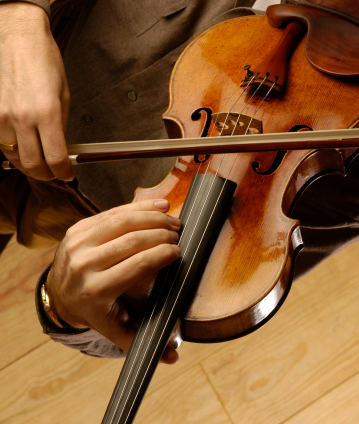Great Violin Concertos: Highlights and discoveries

Since they were founded, the Berliner Philharmoniker have played with the classical world’s leading violin virtuosos. This playlist of concertos from Wolfgang Amadeus Mozart to György Ligeti features violinists who are particularly closely associated with the Philharmoniker as artists in residence or who regularly appear with the orchestra as guest soloists. These include Anne-Sophie Mutter and Frank Peter Zimmermann plus Lisa Batiashvili, Janine Jansen and Christian Tetzlaff.
The history of the violin concerto stretches from Italian Baroque music to the present day. Although the major composers after Vivaldi and Mozart were generally not accomplished violinists themselves (conversely, however, great virtuosos such as Paganini, Henryk Wieniawski, Pablo de Sarasate and Eugène Ysaÿe were often notable composers), almost all of them were attracted by the orchestra’s unique blend of sound with the tone of the violin which can reveal surprising power in the low register and outshines all other string instruments in the high register. After the Baroque and early Classical periods, the violin concerto reached new heights with Ludwig van Beethoven: his opus 61 put the orchestra on an equal footing with the solo instrument and is no less ambitious in terms of both scope and musical content than Beethoven’s great symphonies. Since then, however, the number of violin concertos written by leading composers has decreased considerably: Vivaldi wrote more than 200, Mozart as many as five, and after Beethoven, Schumann, Brahms, Dvořák and Tchaikovsky, among others, have each made only one single contribution to the genre – which makes them all the more dazzling as solitaires.
The repertoire was considerably enriched in the 20th century too, although the geographical focus was broadened: Carl Nielsen and Jean Sibelius contributed powerful solo concertos from Northern Europe, and Sergei Prokofiev and Shostakovich among others in Russia. The Hungarians Béla Bartók and György Ligeti created revolutionary violin concertos in very different ways. Alban Berg’s composition dedicated “to the memory of an angel” – with interwoven Bach chorale and alienated ländler sounds – is one of the most harrowing works of Modernism.
This great repertoire would not exist without the greatest violinists of their respective eras. First and foremost is Joseph Joachim who advised Robert Schumann and Antonín Dvořák, Johannes Brahms and Max Bruch on the development of their violin concertos. David Oistrach had similar significance as a dedicatee and soloist in premieres for the Russian music of the 20th century as Joachim in the 19th century. The Berliner Philharmoniker worked with Joachim and Oistrach on several occasions. Indeed, almost all the great violinists of the 20th century, such as George Enescu, Jascha Heifetz, Christian Ferras, David and Igor Oistrach or Ina Haendel, appeared in concerts of the orchestra.
In 1929, Yehudi Menuhin wrote himself into the annals of Philharmoniker history: at the age of only 13, he performed violin concertos by Bach, Brahms and Beethoven in one evening under the baton of Bruno Walter. In 1977 Herbert von Karajan presented an equally young, no less astonishing child prodigy to the audience: Anne-Sophie Mutter, who became the defining soloist of the late Karajan era.
The remarkable group of violinists of the younger generation is represented in concerts of the orchestra by Janine Jansen, Baiba Skride, Lisa Batiashvili, Isabelle Faust, Vilde Frang and Patricia Kopatchinskaja, among others. Leonidas Kavakos and Christian Tetzlaff, who have had a close relationship with the orchestra for many years, served as artists in residence. Finally, Frank Peter Zimmermann has presented a particularly extensive repertoire with the Berliner Philharmoniker in recent years, ranging from Mozart to a world premiere by the Finn Magnus Lindberg. As long as composers can draw inspiration from such great artists, the future of the violin concerto is secure.
Our recommendations
- “Unanswered Questions”: Musical Modernism between 1910 and 1920
- Enigma Variations: Music with secret and cryptic messages
- Undying fascination: The music of the “Golden Twenties”
- A soprano’s perspective: Marlis Petersen’s favourites
- Gustav Mahler in his works
- On the silver screen: Classical music in film